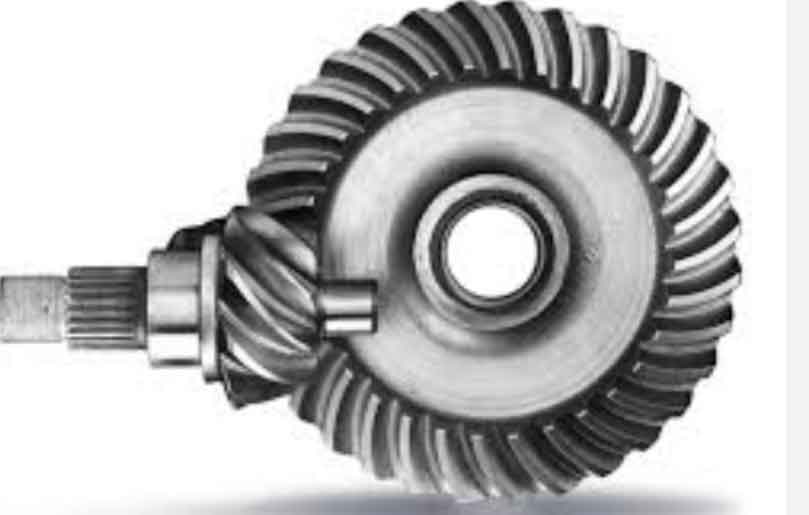
Hypoid gears are widely used in automotive and industrial applications due to their high load capacity and compact design. This paper presents a comprehensive methodology for digital modeling and time-varying meshing analysis of hypoid gears manufactured through the Hyperbolic Face Hobbing (HFT) method.
1. Kinematic Modeling of Hypoid Gear Generation
The mathematical model of hypoid gear generation considers the relative motions between cutting tools and workpieces. For the gear (driven member), the coordinate transformation matrix from tool to workpiece is expressed as:
$$
\mathbf{M}_{gs2} = \mathbf{T}_X(-X_2) \cdot \mathbf{R}_Z(\delta_{M2}) \cdot \mathbf{T}_{YZ}(E_2, -X_{B2}) \cdot \mathbf{T}_{XY}(S_{r2}\cos q_2, S_{r2}\sin q_2)
$$
Where cutting tool coordinates are transformed through sequential operations of translation ($\mathbf{T}$) and rotation ($\mathbf{R}$). The gear tooth surface equation in machine coordinate system becomes:
$$
\mathbf{r}_2 = \mathbf{M}_{gs2} \cdot \mathbf{r}_g = [x_2\ y_2\ z_2\ 1]^T
$$
2. Tooth Surface Formulation
The complete tooth profile of hypoid gears includes working surfaces and root fillets. For pinion concave side machining, the cutter geometry is defined by:
$$
\mathbf{r}_p = \begin{bmatrix}
(r_P + u_p\sin\alpha_1)\cos\theta_p \\
(r_P + u_p\sin\alpha_1)\sin\theta_p \\
-u_p\cos\alpha_1 \\
1
\end{bmatrix}
$$
The meshing equation for conjugate action requires:
$$
\mathbf{n}_p^{c1} \cdot \mathbf{v}_p^{c1} = 0
$$
Where $\mathbf{n}_p^{c1}$ represents the surface normal vector and $\mathbf{v}_p^{c1}$ the relative velocity vector in machine coordinates.
3. Finite Element Modeling
Key parameters for FE analysis of hypoid gear pairs are summarized below:
| Parameter | Pinion | Gear |
|---|---|---|
| Number of Teeth | 10 | 41 |
| Module (mm) | 4.741 | |
| Shaft Angle (°) | 90 | |
| Offset (mm) | -31.8 | |
| Face Width (mm) | 33.637 | 28 |
The mesh generation process employs C3D8R elements with refined contact zones:
$$
\begin{cases}
\text{Pinion:} & 124,800\ \text{elements} \\
\text{Gear:} & 201,600\ \text{elements} \\
\text{Contact Type:} & \text{Finite sliding} \\
\text{Friction Coefficient:} & 0.1
\end{cases}
$$
4. Time-Varying Meshing Characteristics
The dynamic transmission error (DTE) is calculated as:
$$
\Delta\phi(\phi_{h1}) = (\phi_{h2} – \phi_{h2}^0) – \frac{z_1}{z_2}(\phi_{h1} – \phi_{h1}^0)
$$
Time-varying mesh stiffness shows significant load dependence:
| Load (Nm) | Peak Stiffness (N/m) | Phase Shift (°) |
|---|---|---|
| 100 | 2.1×10⁸ | 12.4 |
| 3,000 | 6.8×10⁸ | 8.7 |
| 6,000 | 9.4×10⁸ | 5.2 |
The contact pattern evolution under different loads follows:
$$
A_c(T) = A_0\left(1 – e^{-kT}\right)
$$
Where $A_0$ represents the theoretical contact area and $k$ the load distribution coefficient.
5. Parametric Sensitivity Analysis
Key findings from hypoid gear meshing analysis include:
- Transmission error amplitude decreases 42% when load increases from 100Nm to 6,000Nm
- Mesh stiffness nonlinearity increases by 78% under heavy loading
- Contact ratio improves from 1.92 to 2.35 with 60× load increase
The parametric relationship between load and meshing characteristics is expressed as:
$$
\begin{cases}
F_m = C_1T^{0.67} \\
\Delta\phi_{pp} = C_2T^{-0.31} \\
K_m = C_3\ln(T)
\end{cases}
$$
Where $C_1$, $C_2$, and $C_3$ are system-specific constants.
6. Conclusion
This study establishes a complete digital modeling framework for hypoid gears, enabling accurate prediction of time-varying meshing characteristics. The proposed methodology provides critical insights for optimizing hypoid gear performance in high-power transmission systems.
